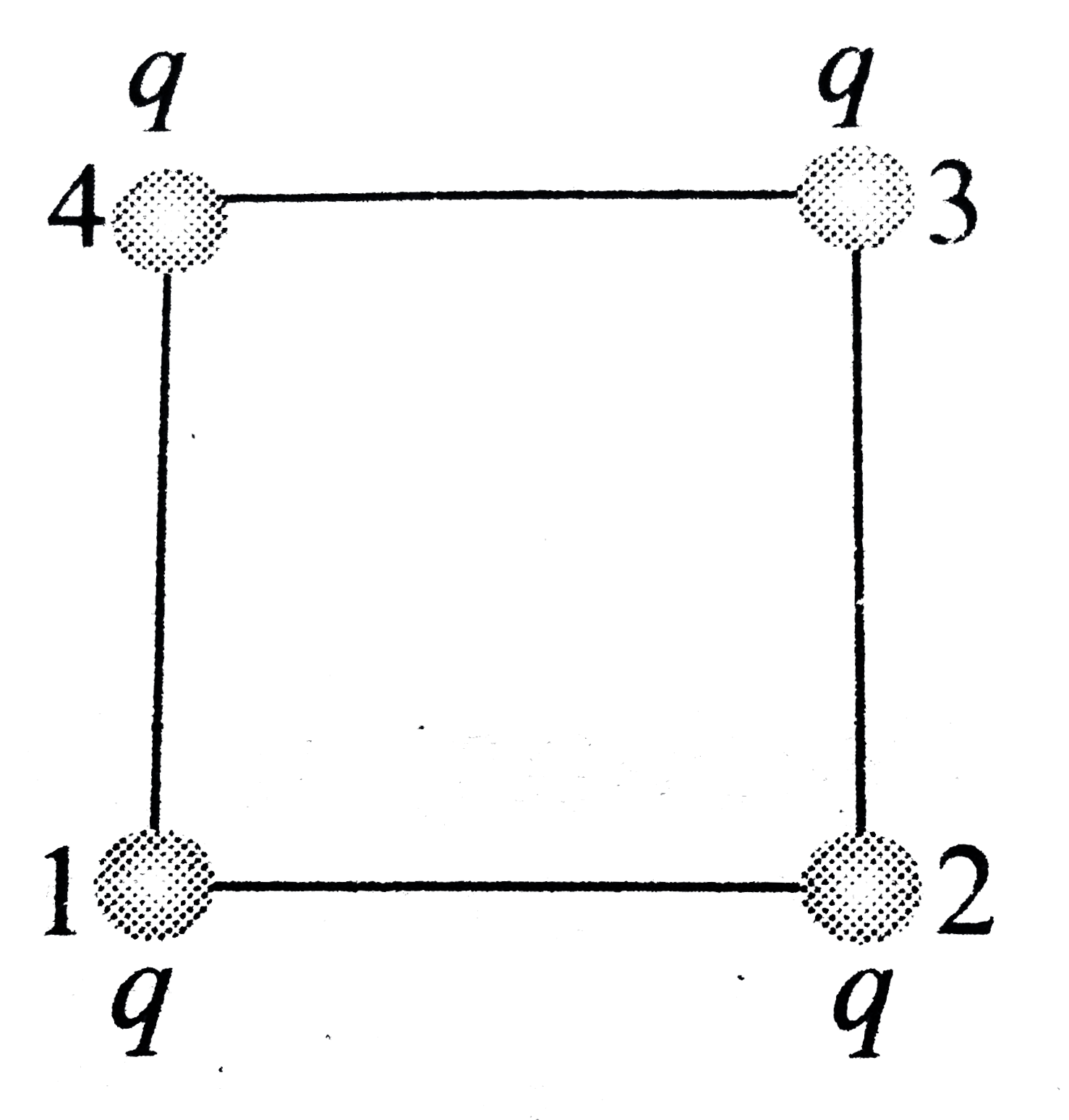Four equal point harges each 16μC are placed on the four corners of a square of side 0.2 m. Calculate the force on any one of the charges.
To solve the problem of finding the force on any one of the charges placed at the corners of a square, we will follow these steps:
Step 1: Understand the Configuration
We have four equal point charges, each of Q=16μC=16×10−6C, placed at the corners of a square with side length a=0.2m. We will calculate the force on charge A due to the other three charges B, C, and D.
Step 2: Calculate the Force Between Charges
Using Coulomb's Law, the force F between two point charges is given by:
F=kQ1Q2r2
where k=9×109N m2/C2 is Coulomb's constant, Q1 and Q2 are the magnitudes of the charges, and r is the distance between the charges.
Step 3: Calculate the Force Exerted by Charge B on Charge A
The distance between charges A and B is equal to the side of the square, a=0.2m.
FAB=kQ2a2=9×109(16×10−6)2(0.2)2
Calculating this:
FAB=9×109256×10−120.04=9×109×6.4×10−9=57.6N
Step 4: Calculate the Force Exerted by Charge D on Charge A
The distance between charges A and D is also a=0.2m:
FAD=FAB=57.6N
Step 5: Calculate the Force Exerted by Charge C on Charge A
The distance between charges A and C is the diagonal of the square, which can be calculated as:
rAC=a√2=0.2√2m
Now, we calculate the force:
FAC=kQ2(a√2)2=kQ22a2=9×109(16×10−6)22(0.2)2
Calculating this:
FAC=9×109256×10−120.08=9×109×3.2×10−9=28.8N
Step 6: Resolve Forces into Components
- The forces FAB and FAD act along the axes, while FAC acts diagonally.
- The components of FAC:
FACx=FACcos(45∘)=28.81√2≈20.4N
FACy=FACsin(45∘)=28.81√2≈20.4N
Step 7: Calculate the Net Force on Charge A
- The net force in the x-direction:
Fnet,x=FAB+FACx=57.6+20.4=78.0N
- The net force in the y-direction:
Fnet,y=FAD+FACy=57.6+20.4=78.0N
Step 8: Calculate the Magnitude of the Resultant Force
Using Pythagorean theorem:
Fnet=√(Fnet,x)2+(Fnet,y)2=√(78.0)2+(78.0)2=√2×(78.0)2=78.0√2≈110.25N
Final Answer
The force on any one of the charges is approximately 110.25N.
We have four equal point charges, each of Q=16μC=16×10−6C, placed at the corners of a square with side length a=0.2m. We will calculate the force on charge A due to the other three charges B, C, and D.
Using Coulomb's Law, the force F between two point charges is given by:
F=kQ1Q2r2
where k=9×109N m2/C2 is Coulomb's constant, Q1 and Q2 are the magnitudes of the charges, and r is the distance between the charges.
The distance between charges A and B is equal to the side of the square, a=0.2m.
FAB=kQ2a2=9×109(16×10−6)2(0.2)2
Calculating this:
FAB=9×109256×10−120.04=9×109×6.4×10−9=57.6N
The distance between charges A and D is also a=0.2m:
FAD=FAB=57.6N
The distance between charges A and C is the diagonal of the square, which can be calculated as:
rAC=a√2=0.2√2m
Now, we calculate the force:
FAC=kQ2(a√2)2=kQ22a2=9×109(16×10−6)22(0.2)2
Calculating this:
FAC=9×109256×10−120.08=9×109×3.2×10−9=28.8N
- The forces FAB and FAD act along the axes, while FAC acts diagonally.
- The components of FAC:
FACx=FACcos(45∘)=28.81√2≈20.4N
FACy=FACsin(45∘)=28.81√2≈20.4N
- The net force in the x-direction:
Fnet,x=FAB+FACx=57.6+20.4=78.0N
- The net force in the y-direction:
Fnet,y=FAD+FACy=57.6+20.4=78.0N
Using Pythagorean theorem:
Fnet=√(Fnet,x)2+(Fnet,y)2=√(78.0)2+(78.0)2=√2×(78.0)2=78.0√2≈110.25N
The force on any one of the charges is approximately 110.25N.
Topper's Solved these Questions
- ELECTROSTATIC FORCES, CHARGES AND FIELDSBOOK - SL ARORACHAPTER - ELECTROSTATIC FORCES, CHARGES AND FIELDSEXERCISE - Problems
18 Videos
- ELECTROSTATIC FORCES, CHARGES AND FIELDSBOOK - SL ARORACHAPTER - ELECTROSTATIC FORCES, CHARGES AND FIELDSEXERCISE - Problems For Self Practice
1 Videos
- ELECTRONS AND PHOTONSBOOK - SL ARORACHAPTER - ELECTRONS AND PHOTONSEXERCISE - TYPE E : Problem For Self Practice
11 Videos
- HEATING EFFECT OF CURRENTBOOK - SL ARORACHAPTER - HEATING EFFECT OF CURRENTEXERCISE - All Questions
192 Videos
Similar Questions
Four equal charges each 16μC are placed on four corners of a square of side 0.4m. Calculate force on q is zero, how are Q and q related ?
View SolutionFour point charges of +1μc each are placed on the four corners of a square of side 1 m. Calculate the electric potential at the centre of the square.
View Solution
Knowledge Check
Charge of 5μC each are placed at the corners of an equilateral triangle of side 10 cm. Then the force on each charge is :-
A78 NB39 NC29 ND22.5 N
Four masses, each equal to M are placed at the four corners of a square of side a. Calculate the force of attraction on another mass m, kept at the centre of the square.
View SolutionFour point charges are placed at the corners of a square of side l. Calculate potential at the centre of square.

View SolutionFour point masses of 10 kg each are placed at the corners of a square PQRS of side 3 cm. Calculate the moment of inertia of the square about an axis coinciding with the side PQ of the square.
View SolutionFour positive point charges Q are placed at the corners of a square of side a. Calculate the charge that should be placed at the centre so that system remains in equilibrium.
View SolutionEqual charges of +4μC are placed at the three corners of an equilateral triangle of side 2m. Calculate the magnitude and direction of the force on one of the charges.
View SolutionFour identical point charges q are placed at four corners of a square of side a. Find the potential energy of the charge system.
 .
.
View SolutionFour charges +q,+2q,+3q and +4q are placed at the four corners ABCD of a square of side a. Calculate the field and potential at the centre of the square.
View Solution
